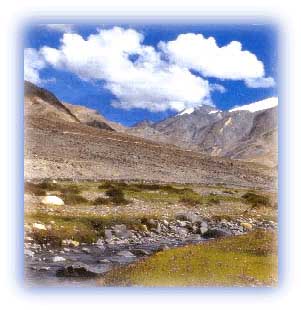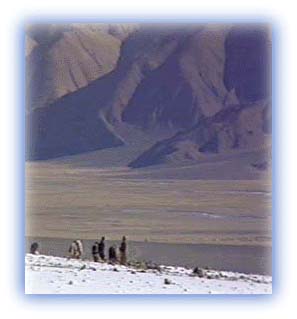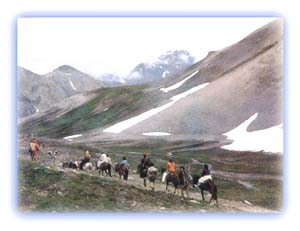Trekking
· General Info
· Prerequisites
· The Terrain
· Preparations
· Physical Conditioning
· Acclimatization
· High Altitude Sickness
· Food and Water
· Exchange of Currency
· Trekking Permits

![]()
| Trekking Methods There are different trekking methods which can be chosen depending on one's inclination, financial resources, physical fitness and most importantly, keeping the time factor in mind. |
The everchanging Himalayan climate. (Download Realplayer) |
 |
| Spring will bring color to the valleys of Ladakh Credit: Discover India magazine |
Through organized trekking agencies/tour operators
There are a large number of trekking agencies in India
and Nepal that organize treks in Sikkim, Nepal, Bhutan,
Kumaon, Garhwal and Ladakh Himalayan regions of India. These
trekking agencies are mostly based at Darjeeling, Kathmandu (Nepal),
Thimpu (Bhutan), New Delhi, Dehradun, Nainital, Simla, Srinagar and Leh (all India). They normally make trekking
arrangements through their
guides and agents and send organized groups to the mountains. The major trekking groups arrive from Europe, United States,
Japan, Australia and New Zealand. Indian trekkers from West Bengal, Gujarat and Maharashtra have also started taking part
in large organized group treks. Also, large trekking parties consisting of college and school students visit the Himalayas.
The arrangements are made according to the demands like arranging ponies, porters, camping equipment and food. Otherwise, the trekking agencies simply provide guides and equipment on hire. The governments are promoting trekking as an important part of tourism and a vital source of foreign exchange. The trekking agencies normally plan completely self sufficient treks carrying their own food, stoves for cooking, utensils and tents. They also plan and cater for the different stages of the trek and do not depend upon local food and accommodation. As a result, camps are established at predetermined points and the trekker is left with plenty of leisure to enjoy the scenic beauty and study the culture, flora and fauna en route. In the evening some trekking agencies organize camp fires and cultural activities to add to the pleasure of the trip. Trekking agents also attend to minor medical problems and help in the case of an accident or if emergency rescuing is required.
The expenses of organized treks are ordinarily not high as trek operators make arrangements for large numbers which lowers the cost per head. According to the normal practice, booking is confirmed in advance by paying a part of the cost of trek. The prices depend on the length of the trek, and the services offered. So far, Nepal has been able to organize their trekking facilities better than India, where few new trekking agencies are well established. The main drawback of organized trekking is that one has to stick to the trekking schedule of the group and can not deviate for interesting side trips on the way. But on the whole, organized treks can be very rewarding and enjoyable.
 |
| On the ancient Central Asian trade route Credit: Karamjeet Singh |
Trekking on your own
The well defined old pilgrim routes in India and Nepal are still being followed by millions of pilgrims and trekkers. Further on,
in the higher altitudes, many people carry their own stores of food, equipment and manage their trips trips themselves. But in
reality, there is no need to carry one's own food stuff and tentage as there are villages and hutments along the way. Due to
this, local
food can be made available on payment and one can easily avoid carrying heavy loads. In case a high altitude trek is planned,
then either a firm base should be made or help from local porters be sought to carry loads and act as a guide. This certainly
provides more adventure and the thrill of trekking in the high Himalayan meadows is a treat not forgotten easily.
Live of the land approach
In this style of trekking, one needs to carry one's own sleeping bag,
rucksack, clothing and other personal items. For other essential
requirements, one depends totally on local food and shelter. There are
usually plenty of local tea shops, small hotels, and private homes which provide food and shelter cheaply.
The people are normally hospitable to those who come for help and guidance. It goes without saying that one cannot expect a rich variety in the food as the local staple diet is generally simple - rice and lentils (Dal-Bhat) and green vegetables. One has to plan the day-to-day routes and anticipate arrangements at next halting places by enquiring in detail so that one gets proper food and shelter at the end of the day. This 'live off the land" approach can certainly allow faster movement and provides more maneuverability for side trips and quick change of plans according to ones own interest. In recent years, different types of hotels are coming up on the road sides which may offer relatively better accommodation facilities. Otherwise, one's sleeping bags and other personal items come in handy. This method of trekking offers the best opportunity to observe the local culture, food habits and the living style of the locals population.
 |
| Negotiating the Mahagunas Pass (4600m), the highest point on the Amarnath trek. Credit: KOA |
Self organized group trekking
Another method of organizing treks is where the group itself
makes complete arrangements for their needs - including porters, transport, food and equipment. This requires advance
planning and contacts at road heads through local people so that on arrival, the porters and equipment are available in time.
Experienced mountaineers and trekkers organize such trips easily as they have prior experience of the requirements and the likely problems faced. The bargaining and negotiations with the porters can be a complicated affair and needs handling with patience, specially during the harvest periods around March-April and in September-October. As most people are engaged in harvesting, few porters are available, which easily translates into exorbitant rates being asked. The preparation of loads and weight can also pose problems and even the best-laid plans can get delayed at the last moment.
The trekking group carries light rucksacks while on the trails, and camping arrangements are made by the porters under the direction of the group leader of the trekking party.
This kind of trekking also has some interesting features. One important point that should be kept in mind is that the porters normally cannot walk along with the trekkers; they follow them in the rear with their heavy loads and might reach late with the loads at the next camp. The detailed list of cooking and camping equipment including food items should be prepared in advance and a lot of patience and understanding is required to properly handle the porters and local shopkeepers while trekking. Once the actual trekking starts, then gradually these minor problems tend to get sorted out by themselves. More understanding is displayed by the entire group and the trip becomes rewarding. The trekking becomes more leisurely and side trips to scenic places can easily be included in the itinerary.
All rights reserved